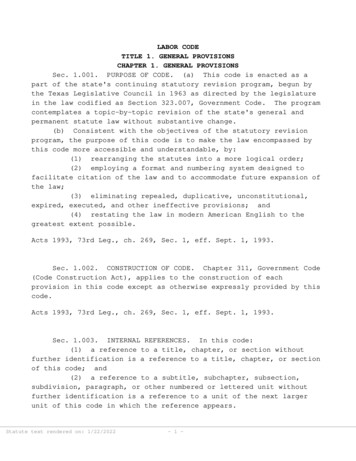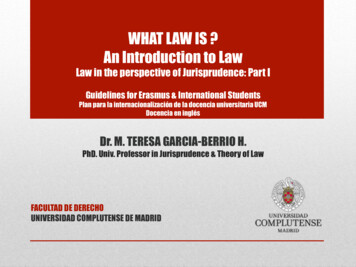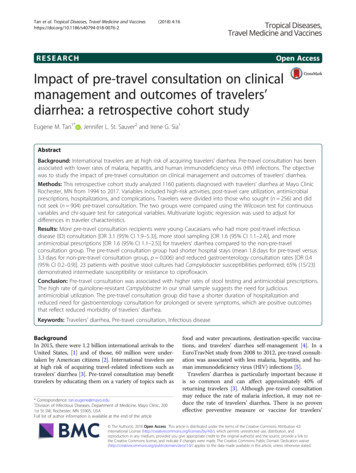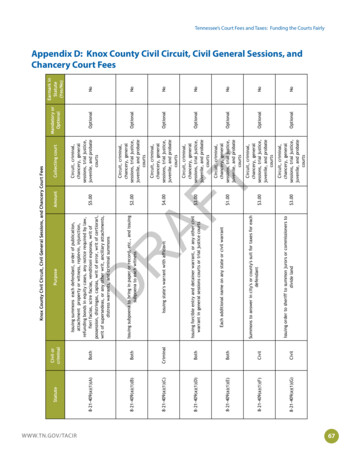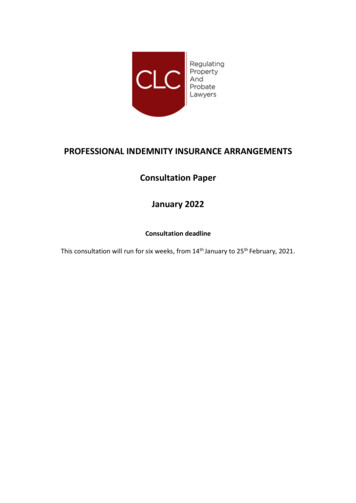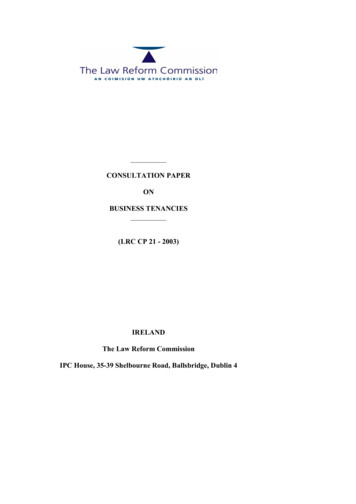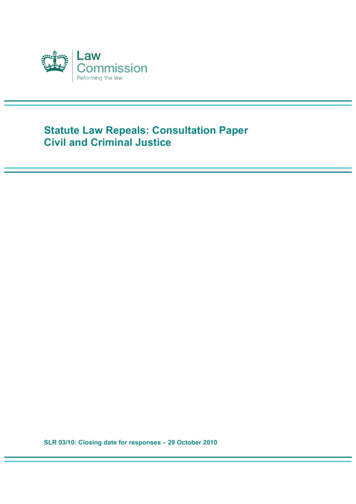
Transcription
Statute Law Repeals: Consultation PaperCivil and Criminal JusticeSLR 03/10: Closing date for responses – 29 October 2010
BACKGROUND NOTES ON STATUTE LAW REPEALS (SLR)What is it?1. Our SLR work involves repealing statutes that are no longer of practical utility.The purpose is to modernise and simplify the statute book, thereby reducing itssize and thus saving the time of lawyers and others who use it. This in turn helpsto avoid unnecessary costs. It also stops people being misled by obsolete lawsthat masquerade as live law. If an Act features still in the statute book and isreferred to in text-books, people reasonably enough assume that it must meansomething.Who does it?2. Our SLR work is carried out by the Law Commission and the Scottish LawCommission pursuant to section 3(1) of the Law Commissions Act 1965. Section3(1) imposes a duty on both Commissions to keep the law under review “with aview to its systematic development and reform, including in particular . therepeal of obsolete and unnecessary enactments, the reduction of the number ofseparate enactments and generally the simplification and modernisation of thelaw”.Statute Law (Repeals) Bill3. Implementation of the Commissions’ SLR proposals is by means of specialStatute Law (Repeals) Bills. 18 such Bills have been enacted since 1965repealing more than 2000 whole Acts and achieving partial repeals in thousandsof others. Broadly speaking the remit of a Statute Law (Repeals) Bill extends toany enactment passed at Westminster. Accordingly it is capable of repealingobsolete statutory text throughout the United Kingdom (i.e. England, Wales,Scotland and Northern Ireland) as well as extending where appropriate to the Isleof Man.Consultation4. The Law Commission consults widely before finalising its repeal proposals. Thepurpose of consulting is to secure as wide a range of views on the proposals asis practicable from all categories of persons who may be affected by theproposals. So the consultation may be with central or local government,organisations, trade bodies, individuals or anyone else who appears to have aninterest in a proposal.5. So far as consulting central government is concerned, any Department or agencywith an interest in the subject matter of the repeal proposal will be invited tocomment. Because obsolete legislation often extends throughout the UnitedKingdom it may be necessary to invite comments from several differentDepartments. So the following will routinely be consulted The English Department or Departments with policy responsibility for the subjectmatter of the proposed repeal (this responsibility will extend to Scotland inappropriate cases) The Welsh Assembly Government and the Wales Office (unless the proposedrepeal relates only to England) SLR colleagues at the Scottish Law Commission (if the proposed repeal extendsto Scotland) Northern Ireland officials (if the proposed repeal extends to Northern Ireland).i
Selection of repeal candidates6. Candidates for repeal are selected on the basis that they are no longer ofpractical utility. Usually this is because they no longer have any legal effect ontechnical grounds - because they are spent, unnecessary or obsolete. Butsometimes they are selected because, although they strictly speaking docontinue to have legal effect, the purposes for which they were enacted either nolonger exist or are nowadays being met by some other means.7. Provisions commonly repealed by Statute Law (Repeals) Acts include thefollowing(a)references to bodies, organisations, etc. that have been dissolved or woundup or which have otherwise ceased to serve any purpose;(b)references to issues that are no longer relevant as a result of changes insocial or economic conditions (e.g. legislation about tithes or tin mines);(c)references to Acts that have been superseded by more modern (or EU)legislation or by international Convention;(d)references to statutory provisions (i.e. sections, schedules, orders, etc.) thathave been repealed;(e)repealing provisions e.g. “Section 33 is repealed/shall cease to have effect”;(f)commencement provisions once the whole of an Act is in force;(g)transitional or savings provisions that are spent;(h)provisions that are self-evidently spent - e.g. a one-off statutory obligation todo something becomes spent once the required act has duly been done;(i)powers that have never been exercised over a period of many years orwhere any previous exercise is now spent.General savings8. Much SLR work is possible because of the general savings provisions of section16(1) of the Interpretation Act 1978. This provides that where an Act repeals anenactment, the repeal does not (unless the contrary intention appears) “(a)revive anything not in force or existing at the time at which the repealtakes effect;(b)affect the previous operation of the enactment repealed or anythingduly done or suffered under that enactment;(c)affect any right, privilege, obligation or liability acquired, accrued orincurred under that enactment;(d)affect any penalty, forfeiture or punishment incurred in respect of anyoffence committed against that enactment;(e)affect any investigation, legal proceeding or remedy in respect ofany such right, privilege, obligation, liability, penalty, forfeiture orpunishment;ii
and any such investigation, legal proceeding or remedy may be instituted,continued or enforced, and any such penalty, forfeiture or punishment may beimposed, as if the repealing Act had not been passed”.Gradual obsolescence9. The obsolescence of statutes tends to be a gradual process. Usually there is nosingle identifiable event that makes a statute obsolete. The Statute Law(Repeals) Act 2008 contained several examples of legislation being overtaken bysocial and economic changes. A scheme to provide farming work for exservicemen after the First World War had long fallen into disuse. Changes inagriculture during the second half of the 20th century had greatly reduced thenumbers of persons seeking employment in farming. An Act of 1792 thatcriminalised the giving of false character references to servants seeking domesticemployment had become superseded by changes in the civil law. And aVictorian Act requiring noisy street musicians to leave the area on pain of a fortyshilling fine had long become obsolete.10. Even within individual statutes, the obsolescence tends to be gradual. Someprovisions fade away more quickly than others. These include commencementand transitory provisions and ‘pump-priming’ provisions (e.g. initial funding andinitial appointments to a Committee) to implement the new legislation. Next to gomay be order-making powers that are no longer needed. Then the Committeeestablished by the Act no longer meets and can be abolished. However, otherprovisions may be unrepealable for generations, particularly if they conferpensions rights or confer security of tenure or employment rights. Otherprovisions may be virtually unrepealable ever. Much of English property law relieson medieval statutes such as Quia Emptores (1290) which is regarded as one ofthe pillars of the law of real property. This last example usefully shows that justbecause a statute is ancient it is not necessarily obsolete.Help from consultees11. Sometimes it is impossible to tell whether a provision is repealable without factualinformation that is not readily ascertainable without ‘inside’ knowledge of aDepartment or other organisation. Examples of this include savings or transitionalprovisions which are there to preserve the status quo until an office-holderceases to hold office or until repayment of a loan has been made. In cases likethese the repeal notes drafted by the Law Commissions often invite theorganisation being consulted to supply the necessary information. Any help thatcan be given to fill in the gaps is much ******iii
iv
CIVIL AND CRIMINAL JUSTICECONTENTSPagesINTRODUCTION1-2GROUP 1 - BINDING OVERJustices of the Peace Act 1361 (c.1) (whole)Magistrates’ Courts (Appeals from BindingOver Orders) Act 1956 (c.44) (partial)3-7GROUP 2 - CRIMINAL PROCESSCriminal Law (Scotland) Act 1830 (c.37) (partial)8 - 10GROUP 3 - DISTRESSStatute of Marlborough 1267 (cc. 4, 15 & 23) (partial)Statutes of the Exchequer (uncertain date,circa 1322) (whole)11 - 19GROUP 4 - EXTRADITIONExtradition Act 1873 (c.60) (whole)20 - 26GROUP 5 - FORGERYForgery of Foreign Bills Act 1803 (c.139) (whole)27 - 30GROUP 6 - FRAUDCriminal Justice (Scotland) Act 1987 (c.41) (partial)Criminal Justice Act 1988 (c.33) (partial)31 - 35GROUP 7 - POLICEPolice Act 1969 (c.63) (whole)36 - 38GROUP 8 - SALE OF PUBLIC OFFICESSale of Offices Act 1551 (c.16) (whole)Sale of Offices Act 1809 (c.126) (whole)Common Informers Act 1951 (c.39) (partial)39 - 44v
vi
Civil and Criminal JusticeIntroduction1. This consultation paper comprises an amalgam of separate notes - looselygrouped under the heading Civil and Criminal Justice - recommending the repealof statutes spanning over 700 years, from the very old (1267) to the relativelymodern (1988).2. The statutes fall within eight categories: Binding over Criminal process (in Scotland) Distress Extradition Forgery Fraud Police (principally in Northern Ireland) Sale of public offices3. The oldest of the statutes deals with the power of justices to bind over defendantsin criminal proceedings (1361) and the regulation of the levying of distress bysheriffs and bailiffs (1267 and probably 1322), which latter provisions were to beenforced through civil proceedings. Although these statutes have historic valuetheir inclusion within the live statute book is no longer warranted. Their functionhas been overtaken by the enactment of 20th and 21st century legislation in eachof these fields.4. Four of the repeal notes have a more limited territorial application. The notes oncriminal process, forgery and fraud focus on provisions which are alive today inScotland, but which have some marginal impact elsewhere in the UnitedKingdom. The purpose is (in one case) to tie the proposed repeals in with repealspresently being enacted in Scotland. The note on police (which is founded onlegislation which facilitated reciprocal policing arrangements between the thenRoyal Ulster Constabulary and mainland forces) focusses on the province of1
Northern Ireland only. The repeal recommended - of the remaining portion of thePolice Act 1969 - simply remedies what appears to have been a repeal oversight.5. Political reforms over the past 140 years (underpinned by modern legislationculminating in the recent Bribery Act 2010) have rendered the 16th century statuteon sale of offices (and its extending Act of 1809) unnecessary and devoid ofpractical purpose.6. Finally, it is worth noting that Statute Law (Repeal) Bills ordinarily apply to theUnited Kingdom and to the Isle of Man, but do not automatically extend to theChannel Islands.1 The repeal note on Extradition, which recommends essentiallyjust a minor tidying-up measure, affects the Isle of Man as well as the UK.1Provision is made in such Bills for extension to the Channel Islands and British overseas territoriesby specific Order in Council where such extension would be appropriate.2
GROUP 1 - BINDING OVERReferenceExtent of repeal or revocationJustices of the Peace Act 1361(34 Edw.3 c.1)The whole Act.Magistrates’ Courts (Appeals fromIn section 1(1), the words “, underBinding Over Orders) Act 1956the Justices of the Peace Act(4 & 5 Eliz. 2 c.44)1361, or otherwise,”.Background1.Justices of the peace (the lay magistracy) came into existence as specific office-holdersduring the reign of Edward 3. They started life as custodians or conservators of the peace2within each county in the 13th century, and by the early 14th century (1327) they were givenpowers to punish offenders.3 From 1359 onwards justices’ commissions (their authority andofficial duties) were consolidated.4 They seem to have acquired the title ‘justices’ [of thepeace] by 1362.52.The justices’ judicial powers were conferred - or at any rate reinforced - in 1361 by thestatute 34 Edw.3 c.1 (“the 1361 Act”). This step marked the office-holders’ transition frompeace keepers to peace adjudicators with powers of legal determination in criminal matters.6The long title to the 1361 Act was:“What Sort of Persons shall be Justices of Peace; and what Authority they shallhave”.73.Today the appointment of, and qualifications for, justices within any commission area inEngland and Wales are governed by Part 2 of the Courts Act 2003 (c.39), and their judicialpowers are set out in the Magistrates’ Courts Act 1980 (c.43).2This title was assigned by the statute 1 Edw.3 St.2 c.16 (1327) (later entitled the Justices of the Peace Act1327).3See 2 Edw.3 c.6 (1328), cited in Sir William Holdsworth A History of English Law, ed. A.L. Goodhart and H.G.Hanbury (7th edn, 1956, London), vol 1 at p 287 and n8.4See Holdsworth, cited above, at p 288.5See 36 Edw.3 St.1 c.12 (1362), cited in Holdsworth, vol. 1 at p288 and n7. Halsbury’s Statutes (2006 reissue)vol 11(2) at p 23 indicates that the 1361 Act was the source of the title ‘justices of the peace’, supplementingreference in the earlier 5 Edw.3 c.11 (1331) (now repealed).6See Esther Moir British Institutions: The Justice of the Peace (1969, Penguin Books, Harmondsworth), chap 1 atp18. Moir makes the point that the statute of 1361 represented a great step forward in the status and role ofjustices, although it had also “erroneously been taken as marking the origin of the office”. From about 1390onwards justices retained their power to determine the indictments they initiated, and their jurisdiction graduallyextended into administrative, local governance and financial matters.7The short title to the Act was assigned by the Statute Law Revision Act 1948, s 5 and Sch 2: see generallythHalsbury’s Laws of England vol 29(2) (4 edn Reissue, 2002, Butterworths) at p 342 para 501.3
Justices of the Peace Act 13614.The 1361 Act required the assigning “in every county of England” of “one lord, and withhim three or four of the most worthy in the county, with some learned in the law” to keep thepeace. These appointees were to have various powers and obligations so as to ensure thatthe King’s people were neither “troubled [n]or endamaged” by rioters or rebels, that thepeace should not be “blemished”, and that merchants and others could go safely about theirbusiness on the highways. The powers were in four categories:8(a) to restrain offenders, rioters and “all other barators”,9 and to pursue, arrest and“chastise” them “according [to] their trespass or offence”;(b) to imprison such persons and ensure they were “duly punished according to thelaw and customs of the realm” (exercising in that regard “good advisement”);(c) to take, arrest and imprison all persons who had been indicted for, or suspectedof, crime; and(d) to take “sufficient surety and mainprise” from persons “[not] of good fame” both toensure “good behaviour towards the King and his people” and to punish theindividuals concerned.105.The provisions of the 1361 Act have been pruned out on two occasions:(i) the Act originally included reference to the questioning by justices of persons whohad been “pillors and robbers in the parts beyond the sea” and who had nowreturned to the realm. This provision was omitted by the Statute Law Revision Act1948;11(ii) the Act included power for justices, at the King’s suit, to hear and determine “allmanner of felonies and trespasses done” within the justices’ county (and for finesimposed to be proportionate, “reasonable and just”). This provision was repealedby the Criminal Law Act 1967.126.In 1956 the 1361 Act was supplemented by the Magistrates Courts (Appeals fromBinding Over Orders) Act,13 which provided a right of appeal to quarter sessions (now theCrown Court) from magistrates’ binding over orders. Although the body of the 1956 Act doesnot speak of binding over in terms, nonetheless the combination of the short title and section8The 1361 Act was not divided into sections as such. The provisions summarised below appeared in a singlesection, sub-divided into clauses, each differentiated by a semi-colon.9Barators (or barrators) were persons who deliberately sought to cause discord within the community or whowere vexatious litigants. The common law offence of barratry was abolished in 1967 as obsolete.10This was the commencement of the power, vested in justices, to order the binding over of individuals to keepthe peace.111948 (c.62).121967 (c.58), s 10(2), Sch 3 Pt 2.131956 (c.44) (“the 1956 Act”), s 1. The 1956 Act applies only in England and Wales: see section 2(2).4
1(1) means that the powers in the 1361 Act to order a person “to enter into a recognisance14with or without sureties to keep the peace or to be a good behaviour”, and to bind over anindividual, are one and the same.157.The power to bind over is also included within two more modern statutes: the Justicesof the Peace Act 196816 and the Magistrates’ Courts Act 1980.178.Section 1(7) of the Justices of the Peace Act 1968 is one of the few remainingprovisions alive within that Act. It makes a specific declaration that - “any court of recordhaving a criminal jurisdiction has, as ancillary to that jurisdiction, the power to bind over tokeep the peace, and power to bind over to be of good behaviour, a person who or whosecase is before the court, by requiring him to enter into his own recognisances or to findsureties or both, and committing him to prison if he does not comply”.189.Likewise, the Magistrates’ Courts Act 1980, s 115 provides a power to a magistrates’court to bind over an individual to keep the peace or to be of good behaviour, but only onspecific complaint by another individual. In this sense the 1361 Act powers (and the 1968 Actpowers) are wider because the court there can act of its own volition.10.Whereas an order under the 1980 Act may only be made after the case has beencompleted, an order under the 1361 Act can be made at any time during the proceedings(subject to affording the parties concerned adequate opportunity to make representations,and to there being a likely risk of future breach of the peace).19 There is no upper limit oneither the bind-over period or the recognisance forfeitable.20 That said, there appears to beno restriction on the exercise by a criminal court of the powers within the 1968 Act, so longas the order is made against “a person who or whose case is before the court”.2114A recognisance is a form of monetary bond, which binds the maker to a certain course of conduct.See the 1956 Act, long title and s 1(1). Section 1(1) refers to such an order being made “under the Justices ofthe Peace Act 1361, or otherwise”, which suggests that there may also be some common law power in thisregard.161968 (c.69) (“the 1968 Act”).171980 (c.43) (“the 1980 Act”).18Words originally at the end of the subsection were repealed by the Administration of Justice Act 1973 (c.15), ss19(1), 20(6), Sch 5 Pt 1. Section 1(7) is still operative in England and Wales, although it does not now apply inScotland (where it was repealed by the District Courts (Scotland) Act 1975 (c.20), s 24(2), Sch 2). In Scotlandtoday binding over is governed by [SLC: please insert current statutory provision]. The 1361 Act (as a pre1707 English statute) never applied in Scotland.19thSee Halsbury’s Laws of England vol 29(2) (4 edn Reissue, 2002) at p606 para 782 n 6, citing R v AubreyFletcher, ex p Thompson [1969] 1 WLR 872, DC.20See Law Commission report Binding Over (Law Com No.222, February 1994) at para 1.4.21See, for example, R v Kingston-upon-Thames Crown Court, ex p Guarino [1986] Crim LR 325, DC, where abinding over order made against a potential (but not actual) witness under the 1968 Act was quashed as beyondthe court’s jurisdiction (following R v Swindon Crown Court, ex p Singh [1984] 1 All ER 941, DC).155
11.Because the other provisions within the 1361 Act have been superseded by moremodern arrangements, and are now obsolete (for example, the provision specifying thenumber of justices to sit in each county, and that relating to the restraining of rioters andbarators), it is appropriate now to repeal the whole of the 1361 Act, including the binding-overprovisions. In practical terms the 1968 Act and the 1980 Act provide adequate power tojustices to exercise a bind-over function. And, by leaving in place the bulk of the (very short)1956 Act, adequate provision remains for appeal to the Crown Court.12.Repeal of the 1361 Act would have consequences for the 1956 Act.22 At present the1956 Act speaks of a person being ordered by a magistrates’ court to enter into arecognisance to keep the peace or to be of good behaviour “under the Justices of the PeaceAct 1361, or otherwise”.23 If these words are deleted the 1956 Act will still apply to bindingover orders made under the 1968 and 1980 Acts, and at common law.13.It should be noted that as recently as 1998 the Divisional Court treated the 1361 Actprovisions as still being operative.24 But the court had no reason on that occasion to consider(and did not consider) whether the binding over order could better have been imposed underanother power.14.The power under the 1361 Act is neither obsolete nor spent: but it is unnecessary (andof no practical utility) because it has been duplicated by more modern powers.22The Law Commission in its 1994 report (Law Com No.222) did recommend the abolition of the power to bindover in the 1361 Act, but only on the basis that all binding over powers should, as a matter of public policy, beabolished without replacement. This repeal would have included the whole of the 1956 Act.23The 1956 Act, s 1(1).24See R v Clerkenwell Metropolitan Stipendiary Magistrate, ex p Hooper [1998] 1 WLR 800, DC. Where there hadbeen disruptive behaviour in the face of the court, the magistrate had imposed a binding over order under the1361 Act rather than under the Magistrates’ Courts Act 1980, s 115(1). The order itself was valid, but theprocedure adopted by the magistrate for taking the defendant’s own recognisance, and for providing of a separatesurety, was (on the particular facts) flawed.6
Extent15.The 1361 Act extended across England and Wales, although it purported to apply onlyto the counties in England. The 1956 Act (which built upon the 1361 Act powers, andsupplemented the law relating to binding over) applies only in England and Wales.Consultation16.HM Treasury, the Ministry of Justice, the Home Office, the Magistrates’ Association,and the relevant authorities in Scotland and Wales have been consulted about these repealproposals.LAW/005/022/06 andLAW/005/026/06July 20107
GROUP 2 - CRIMINAL PROCESSReferenceExtent of repeal or revocationCriminal Law (Scotland) Act 1830Section 2.11 Geo.4 & 1 Will.4 c.37)Section 6.Criminal Law (Scotland) Act 1830 (11 Geo.4 & 1 Will.4 c.37)Purpose1.By 1830 it had become “expedient” (in order to disarm various persons in the ScottishHighlands more effectively, and to secure “the peace and quiet” of that part of the realm)25 toadjust the provisions in an Act of 172426 which provided that capital punishments (followinga finding of guilt by a court) should not be carried out within fixed periods.27 Under theCriminal Law (Scotland) Act 1830 (“the 1830 Act”) those periods would be abridged.282.The 1830 Act also made provision for various criminal procedural issues: provision ofadditional circuit courts, service of proceedings, summoning of witnesses, administeringbanishment as a punishment, preparation of lists of jurors, and making of gaol committalreturns.293.Today only sections 2, 6, 7 and 13 of the 1830 Act remain unrepealed. They provide asfollows (a) section 2 abridged the periods for the execution of capital sentences (mentionedabove);(b) section 6 dealt with the transmission of prisoners under warrant to gaol or tocourt, and authorised an “officer of the law” to effect conveyance through anyadjoining county;25See preamble to 11 Geo.4 & 1 Will.4 c.37 (1830) (Criminal Law (Scotland) Act) (“the 1830 Act”), being “An Actto amend an Act of the Ninth Year of His late Majesty King George the Fourth, to facilitate Criminal Trials inScotland, and to abridge the Period now required between the pronouncing of Sentence and Execution thereof, inCases importing a Capital Punishment”. The Act to be amended was 9 Geo.4 c.29 (1828), discussed below.2611 Geo. 1 c.26 (1724) (Bail in Criminal Cases (Scotland) Act), which Act was repealed in 1892.27The fixed periods were: 30 days for capital sentences pronounced in Edinburgh or to the south of the Firth ofForth, and 40 days for such sentences pronounced to the north.28The periods were to be revised down to 15 to 21 days for sentences pronounced in Edinburgh or southwards,and 20 to 27 days for sentences pronounced northwards: see the 1830 Act, s 2. Section 1 repealed the periodspreviously prescribed in the 1724 Act.29See the 1830 Act, ss 3 to 15 and Sch.8
(c) section 7 dealt with the “citation” (the summoning) of jurors and witnesses fortrials; and(d) section 13 extended the civil immunity of “all inferior judges and magistrates”(contained in the statute 9 Geo. 4 c.29 (1828))30 when “apprehending any party,or [when acting] in regard to any criminal cause or proceeding, or to anyprosecution for a criminal penalty”.4.Two of these four sections are now obsolete and may be repealed.5.So far as section 2 is concerned, with the abolition of the death penalty for murder in1965,31 and reinforcement of that position through the Human Rights Act 1998 which (asamended) abolished the death penalty in its entirety in the United Kingdom,32 the section isnow superseded and can be repealed.6.There is no need today for section 6 of the 1830 Act because the courts service and theprison service operate on a national rather than a county basis. The section can be repealed.7.Section 7 continues to have value. The section was part-repealed in 1891,33 and wasamended by the Criminal Procedure (Scotland) Act 1975.34 The amendment refocused theprovision so that “an officer of the law” could, without requiring a separate witness, give a“citation” (a summons) for a juror or witness in only a “civil cause or proceeding” rather thanin both civil and criminal proceedings. Section 72 of the 1975 Act made alternative provisionfor citation of jurors and witnesses in criminal matters.8.Section 7 is still required for civil proceedings in Scotland, and should therefore not berepealed.35309 Geo.4 c.29 (1828) (Circuit Courts (Scotland) Act) (“the 1828 Act”) was passed to permit the holding ofadditional “circuit courts of judiciary” to handle criminal trials in Scotland, given (as the Act’s preamble put it) “thegreat increase of criminal offences” North of the Border. Only section 26 of the 1828 Act remains unrepealed.That section (as amended) provides that in Scotland the provisions of 43 Geo.3 c.141 (1803) (“the 1803 Act”),which gave justices protection from damages awards in cases of wrongful conviction, would extend to “all inferiorjudges and magistrates” in sentencing as well as in procedural matters.31See the Murder (Abolition of Death Penalty) Act 1965 (c.71), which Act extended to Scotland.321998 (c.42), s 1(2),(3) and Sch 1 Pt 3 (13th Protocol, art 1).33See Statute Law Revision Act 1891 (c.67), s 1 and Sch, which omitted the opening words “It is hereby providedthat” in section 7.341975 (c.21) (“the 1975 Act”), s 461 and Sch 9 para 5. Although the 1975 Act was later repealed in whole by theCriminal Procedure (Consequential Provisions) (Scotland) Act 1995 (c.40) s 6 and Sch 5 - consequential upon amajor criminal law and procedure consolidation exercise for Scotland - the 1975 amendment was saved by virtueof the Interpretation Act 1978 (c.30), s 16(1).35We are grateful to the Deputy Legal Secretary to the Lord President in Scotland (David Smith) for indicating tous that, although the Sheriff Court Rules (1993, 2002) are consistent with the terms of section 7 of the 1830 Act,the Court of Session Rules (1994) appear out of step in that they still provide for citation of a witness by a9
9.Section 13, likewise, should not be repealed: it is required for Scotland whilst the 1803and 1828 Acts remain alive.Extent10.Although the 1830 Act appears from its short title to apply to Scotland only, it probablyextends also to England, Wales and Northern Ireland.Consultation11.HM Treasury, the Ministry of Justice, the Home Office, HM Courts Service, HM PrisonService, and the relevant authorities in Northern Ireland, Scotland and Wales have beenconsulted about these repeal proposals.LAW/005/026/06July 2010messenger-at-arms to be witnessed. On that basis - pending an amendment to the 1994 Rules - section 7 shouldremain in force.10
GROUP 3 - DISTRESSReferenceExtent of repeal or revocation52 Hen.3 (1267)(Statute of Marlborough)Chapter 4.Chapter 15.Chapter 23.Statutes of the ExchequerThe whole Act.(statutes of uncertain date)Note: The repeals in this part of the consultation paper will only go forward into thedraft SL(R) Bill when it is confirmed that Part 3 of the Tribunals, Courts andEnforcement Act 2007 (c.15) has been brought into force by Commencement Order,and the relevant Regulations have been made.Statute of Marlborough 1267Purpose1.In 1267 King Henry 3, “for the more speedy ministration of justice” in his realm (whichwas then beset “with manifold troubles and dissensions”), enacted a statute which wasdesigned “to devise convenient remedy” for these ills and to regulate the way in whichpersons of all estates in life could seek redress for grievances suffered.362.As originally enacted the Statute of Marlborough encompassed a preamble and some29 chapters,37 covering the taking of distress without lawful authority, through issues such asconfirmation of Magna Carta (the Great Charter)38 and the Charter of the Forests,39appearance at sheriffs’ “turns”,
Civil and Criminal Justice Introduction 1. This consultation paper comprises an amalgam of separate notes - loosely grouped under the heading Civil and Criminal Justice - recommending the repeal of statutes spanning over 700 years, from the very old (1267) to the relatively modern (1988). 2. The statutes fall within eight categories:
